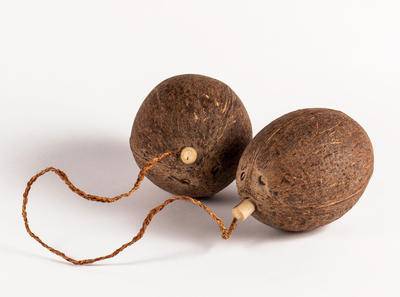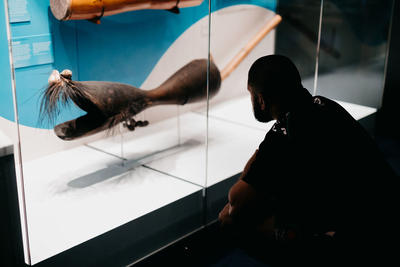Water container (basor)
Production date
1978
Country
Australia
State/Province
Queensland
See full details
Object detail
Description
Two empty coconut shells (from the fruit of Cocos nucifera), each shell pierced through one "eye", and joined by a length of plaited 3-ply fibre string (MOUTI) to form a pair. String, made of fibre from the SIM tree (Hibiscus tiliaceus], is held in place by a knot tied at each end, inserted into the "eyes" of the coconut shells; the hole in each shell is plugged by a shaped piece of cylindrical wood (SIM [Hibiscus tiliaceus]). The plugs are removable. The pair of coconut shells, thus joined and plugged, form a water carrier (NI SOR or BASOR).
Classification
INDIGENOUS CULTURES Aboriginal and Torres Strait Islander container
Maker
Production date
1978
Production place
Measurements
Coconuts: a) L150 x W110mm b) L165 x 120 mm
Weight:417g
Weight:417g
History and use
"The basor is made from the mature coconut fruit shell. Our ancestors used the coconut shell from the Au Lid Lid UU (big coconuts). Firstly, newly brown coconuts are collected, and the Mes (coconut husks) are removed on the Wett, the coconut husking stake. The round shell is then pierced at the drinking hole and the coconut water is then drained. The two shells are then secured under a Miskor (big clam shell). The coconut shell is then immersed in the sea for about two months, until the fleshy meat on the inside of the two shells disappears." - Maryann Sebasio, Erub Elder
Two different types of vessels were usually used on canoe journeys - bamboo tubes and coconut shells. Coconut shell water bottles were usually found in pairs and tied together with plaited cord. The basor were hung from the side of the canoes to be kept cool in the sea water. These basor were made by Asou Omey. Basor is the Meriam Mir name for the containers.
This item was most recently on display in the exhibition 'Connections across the Coral Sea: A story of movement' at Museum of Tropical Queensland (2021-2022) and Queensland Museum (2022-2023).
Two different types of vessels were usually used on canoe journeys - bamboo tubes and coconut shells. Coconut shell water bottles were usually found in pairs and tied together with plaited cord. The basor were hung from the side of the canoes to be kept cool in the sea water. These basor were made by Asou Omey. Basor is the Meriam Mir name for the containers.
This item was most recently on display in the exhibition 'Connections across the Coral Sea: A story of movement' at Museum of Tropical Queensland (2021-2022) and Queensland Museum (2022-2023).
Associated person
Registration number
QE25122




